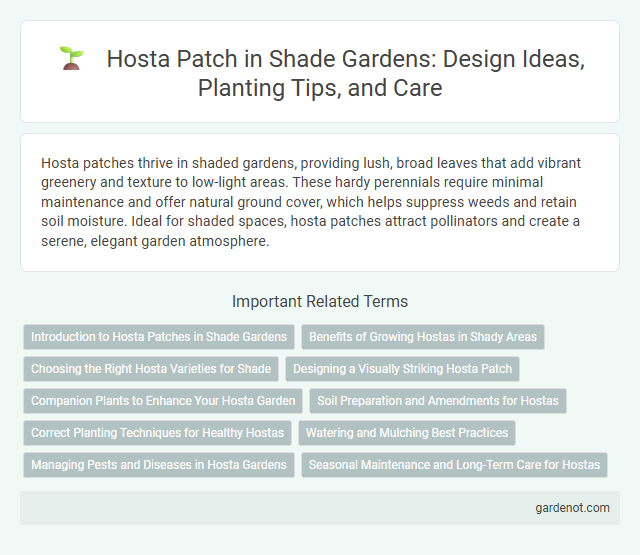Hosta patches thrive in shaded gardens, providing lush, broad leaves that add vibrant greenery and texture to low-light areas. These hardy perennials require minimal maintenance and offer natural ground cover, which helps suppress weeds and retain soil moisture. Ideal for shaded spaces, hosta patches attract pollinators and create a serene, elegant garden atmosphere.
Introduction to Hosta Patches in Shade Gardens
Hosta patches thrive in shade gardens, offering lush, broad-leaved foliage that enhances undercanopy landscapes. These perennial plants adapt well to low-light conditions, providing texture and color variation with green, blue, and variegated leaf patterns. Their hardy nature and low maintenance requirements make hosta patches ideal for creating vibrant, shaded garden areas throughout the growing season.
Benefits of Growing Hostas in Shady Areas
Hostas thrive in shady areas, providing lush foliage that enhances garden aesthetics while requiring minimal sunlight. Their broad leaves improve soil moisture retention and prevent erosion, making them ideal for understory planting. Hostas also attract pollinators like bees and hummingbirds, contributing to a balanced garden ecosystem.
Choosing the Right Hosta Varieties for Shade
Selecting the right Hosta varieties for shade depends on factors like leaf size, color, and growth habit to complement the garden's light conditions. Varieties such as 'Blue Mouse Ears' and 'Patriot' thrive in deep shade, offering vibrant foliage and low maintenance requirements. Consider disease resistance and mature size to ensure optimal growth and aesthetic appeal in a shade garden environment.
Designing a Visually Striking Hosta Patch
Creating a visually striking Hosta patch involves selecting a variety of Hosta cultivars with contrasting leaf colors, sizes, and textures to add depth and interest in shaded garden areas. Incorporating variegated Hostas alongside solid green and blue-leaf varieties enhances visual appeal and highlights unique foliage patterns. Strategic spacing and layering ensure optimal growth and showcase the lush, broad leaves that define an inviting shade garden centerpiece.
Companion Plants to Enhance Your Hosta Garden
Companion plants that thrive in shade such as ferns, astilbes, and heucheras complement hosta patches by adding diverse textures and colors, enhancing the garden's visual appeal. Incorporating shade-tolerant bulbs like bluebells or daffodils provides seasonal interest and contrasts with the broad, lush hosta leaves. Selecting plants with similar moisture and soil requirements ensures a harmonious, low-maintenance shade garden ecosystem.
Soil Preparation and Amendments for Hostas
Rich, well-draining soil with high organic matter content is essential for cultivating a thriving Hosta patch. Incorporate compost or aged manure to enhance soil fertility and moisture retention, while maintaining a slightly acidic to neutral pH level (6.0 to 7.5). Regularly amending the soil with organic mulches supports root health and suppresses weeds in shaded garden areas.
Correct Planting Techniques for Healthy Hostas
Plant hostas in well-draining, rich organic soil with a pH between 6.0 and 7.5 to promote strong root development and vibrant foliage. Space each plant 18 to 36 inches apart to ensure adequate air circulation and prevent disease. Water deeply and consistently, especially during dry spells, to maintain moisture without causing waterlogged roots.
Watering and Mulching Best Practices
Hosta patches thrive in consistently moist, well-drained soil, requiring regular watering especially during dry spells to prevent leaf scorch and promote lush growth. Applying a 2-3 inch layer of organic mulch such as shredded bark or compost helps retain soil moisture, regulate temperature, and suppress weeds. Mulching also reduces soil erosion and improves root development, making it a crucial practice for maintaining a healthy hosta patch in shaded garden areas.
Managing Pests and Diseases in Hosta Gardens
Hosta patches require vigilant management to prevent common pests like slugs, deer, and aphids from damaging foliage. Applying organic slug baits, deer repellents, and regular aphid inspections can significantly maintain plant health. Proper spacing and mulching improve air circulation, reducing fungal diseases such as crown rot and leaf spot in shade garden environments.
Seasonal Maintenance and Long-Term Care for Hostas
Hosta patches thrive with seasonal maintenance that includes removing dead leaves in spring and applying mulch to retain moisture during summer. Regular watering and fertilization using balanced, slow-release fertilizers enhance growth and foliage health throughout the growing season. Long-term care involves dividing mature clumps every 3 to 5 years to prevent overcrowding and maintain vigor, while monitoring for pests such as slugs to ensure optimal plant health.
Hosta patch Infographic

 gardenot.com
gardenot.com